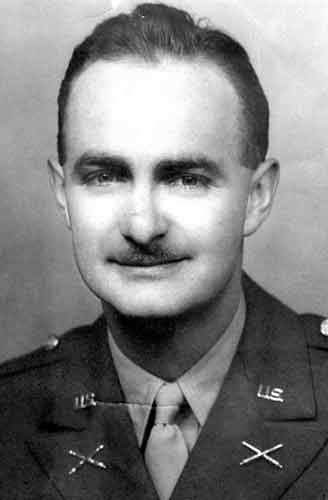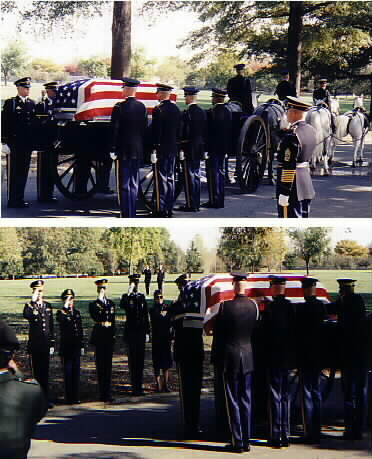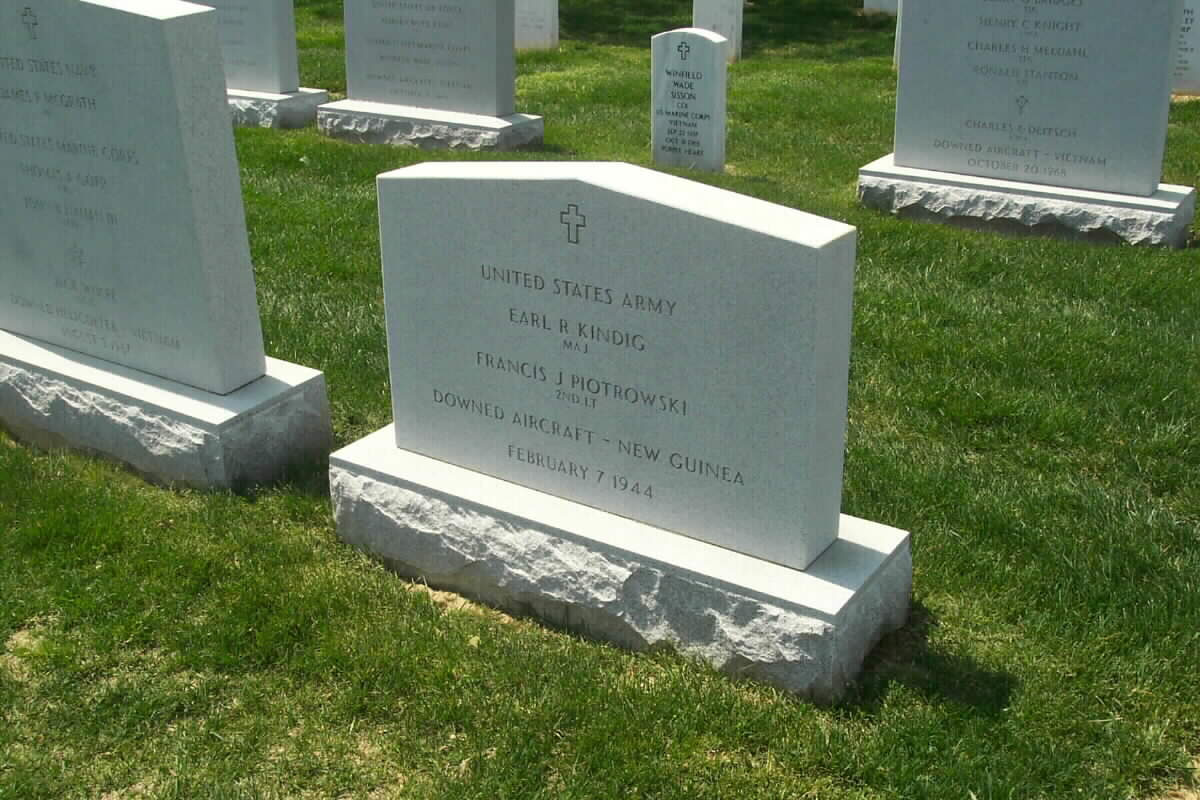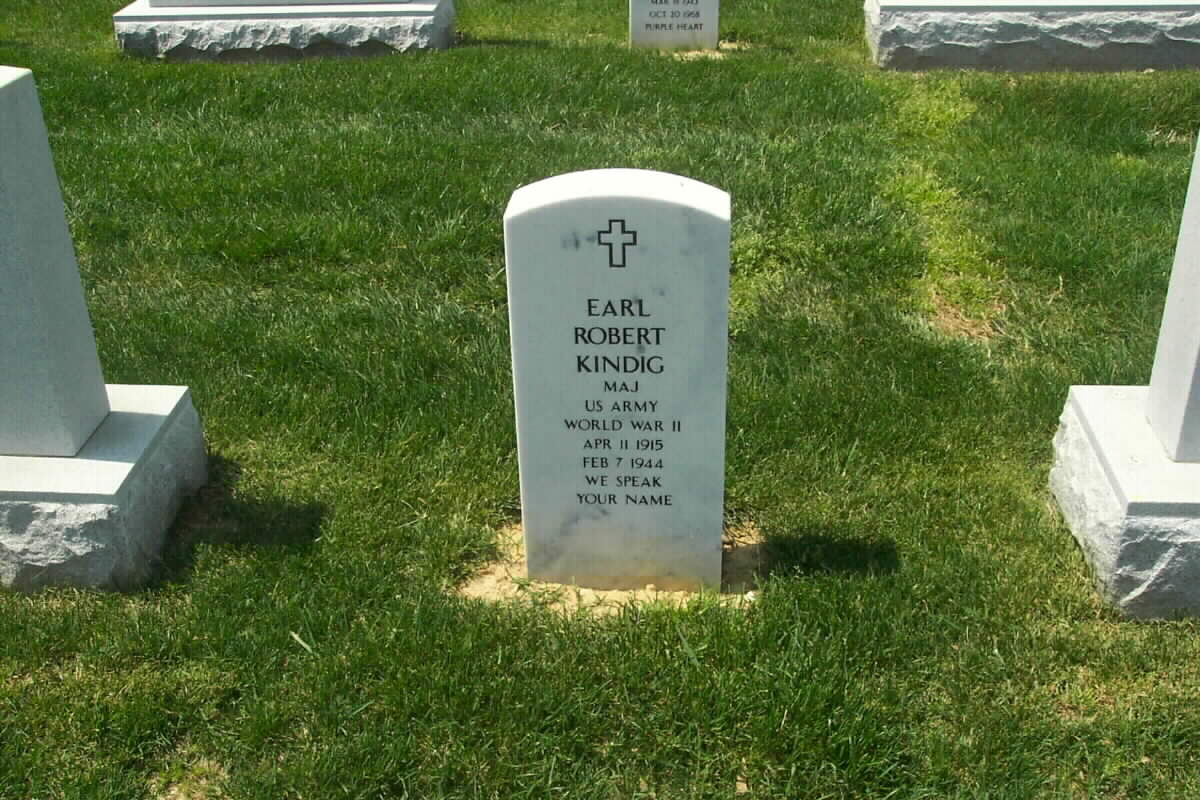From a press report: 6 September 2003
War orphans find each other while searching for their fathers
Courtesy of The Rocky Mountain News
September 6, 2003
It’s highly unlikely the soldiers knew each other.
Lieutenant George Phillip Gaffney Jr. and Major Earl Robert Kindig shared a legacy of courageous service to their country, which led to the ultimate sacrifice.
Each disappeared on flights over mountainous terrain in New Guinea five weeks apart in 1944, the wreckage undiscovered for 54 years.
Finally, there’s another piece to their legacy: love.
Their only children, who met while searching for their fathers’ remains, were married in June and live in Lakewood, Colorado.
Patricia Gaffney wasn’t born when her father perished. Michael Kindig was 3. Both their mothers remarried and they were integrated into new families, but grew up with a sense of loss and longing.
“My mother did speak of my father with love and respect. I did know his family and had some pictures of him. I also had a sense of being different and isolated,” Patricia said.
“We never really knew. That leads the mind to imagine and give some possibility that they survived. I grew up thinking perhaps he was living with the native people, that he had amnesia and he was looking for me.”
Kindig was adopted by his mother’s new husband, an Army doctor.
“My father became a mythic figure with no dimensions. Not until my 21st birthday when I inherited a trunk with his dress saber, letters and journals did I get a sense of the awful loss of what I’d been deprived of,” he said. “That fueled my search.”
The War Orphans Education Act paid for their college education. Michael settled in Colorado, where, known by his adoptive name of Michael Osborn, he became editor of the Colorado Labor Advocate and an actor. Patricia lived in New Haven, Conn., and built a career in arts and education.
Ten years ago, Patricia was watching ABC’s Good Morning America and saw an interview with Janice Olsen, a shopping mall manager from California who tracked down World War II plane crashes in New Guinea in her spare time.
“I contacted her through ABC and we became fast friends,” Patricia said. “She helped me go through the documents I had and the value of them. Eighteen months later I went to New Guinea and went to the places my father had been. It was a very emotional and liberating experience.”
Eventually, Patricia met Alfred Hagen, a Philadelphia businessman who had been to New Guinea seeking the wreckage of his great-uncle’s plane. In the fall of 1997, Hagen went back to New Guinea, stopped at a village in the Finesterres Mountains and asked the locals if they knew of any wrecks. They directed him to two sites, one of which was a plane that matched the one Patricia’s father had piloted.
A team from the Army Central Identification Laboratory in Hawaii (CILHI) identified the plane and found remains that led to confirmation through dental records she had obtained that they belonged to her father. He was buried at Arlington National Cemetery in 1999.
“My mother is still living and she said this had given her a sense of peace she hadn’t known in 55 years,” she said.
Patricia and Michael had each discovered the American WWII Orphans Network (AWON), a support, service and resource organization for World War II orphans. Patricia, who has since become AWON’s president, announced on the group’s Web site that she had found her father’s remains. Michael saw the posting, noticed it was the same area where his father vanished, and contacted her.
Going over notes from Hagen’s earlier trip, Patricia noticed a footnote that said he’d found a plane that matched the type Michael’s father had been in.
In March 2000, a CILHI team discovered remains including bones and a Zippo lighter. However, they couldn’t distinguish the remains of Michael’s father and the plane’s pilot, and his best hope seemed to be a joint internment.
“They needed mitochondrial DNA from my mother, sister or aunt. I wasn’t eligible and was losing hope but they tracked down my 92-year-old great-aunt and got a stone lock match. In October 2001, my father was laid to rest in Arlington, about a block away from George P. Gaffney Jr.,” he said.
Michael’s wife, Denver journalist Sherry Keene-Osborn, died in February 2000.
“A year or so after that, our relationship began to shift a little bit,” said Patricia, who had been divorced for more than 20 years.
They met for the first time in October 2002, at AWON’s national convention in Branson, Missouri. Both were smitten.
When Michael returned to Denver, he went straight to the Shane Co. and bought an engagement ring. Over the Thanksgiving weekend he proposed and they commenced a cross-country relationship.
“I can negotiate DIA blindfolded,” Michael joked. They were married June 28, which he recently verified “was the date Fred Hagen came upon my father’s wreck site.”
Part of their honeymoon was a stop at Arlington to pay respects to their fathers.
“We have come to the conclusion that there’s something mysterious about this, that may be the only word that describes it; that we’ve been essentially looking for each other going back to the days of World War II,” Michael said.
“We tend to credit our fathers, whose nicknames were Bub and Duke. Neither of us is particularly spiritual but this is an area we step aside from and shake our heads.”
Earl R. Kindig
Major, U.S. Army
0-022640
121st Field Artillery Battalion, 32nd Infantry Division
Entered the Service from: Iowa
Died: February 8, 1945
Missing in Action or Buried at Sea
Tablets of the Missing at Manila American Cemetery, Manila, Philippines
Awards: Legion of Merit, Purple Heart

Major Earl R. Kindig, a soldier in the 32nd “Red Arrow” Infantry Division who has been Missing In Action since 7 February 1944, has been found and is coming home!
Mike Kindig Osborne, Major Kindig’s son, has shared the following information about his father’s return:
Army officer coming home…over a half-century after his death
Major Earl Robert Kindig, a Regular Army officer and Field Artillery battalion commander, is coming home 57-1/2 after having been presumed killed-in-action in the jungles of Papua New Guinea in World War II.
Thanks almost exclusively to the dedicated work of Fred Hagen, a Philadelphia contractor who routinely visits New Guinea to search for American wrecks and remains of MIA servicemen; Patricia Gaffney-Ansel, of New Haven, Connecticut, who also lost her father, a 5th Air Force fighter pilot (whose remains were recovered a short distance from the Kindig crash site and subsequently buried at Arlington National Cemetery); and the men and women of the Army’s Central Identification Laboratory, Hickam Air Force Base, Hawaii, Major Kindig’s remains will be buried at Arlington by the Army’s Third Infantry “Old Guard” Regiment during the first week of October.
Major Kindig, who was posthumously awarded the Legion of Merit and the Order of the Purple Heart for his actions on 7 February 1944, had gone aloft that day in a light aircraft to direct artillery fire on columns of Japanese forces – with what would have been otherwise unattainable precision. His plane never returned.
Kindig’s only offspring, Michael Kindig Osborn, lives in Denver and is the editor of the state’s AFL-CIO newspaper, the Colorado Labor Advocate. He will travel to Hawaii to meet the CILHI staff and escort his father’s remains to Arlington.
At the time of his disappearance, Major Kindig was the Commanding Officer of the 121st Field Artillery Battalion, 32nd Infantry Division.
More information about Major Kindig’s long journey home can be found below.
Special Bulletin Regarding Major Earl Kindig:
121st FA Bn., 32nd “Red Arrow” Infantry Division
In case you missed it, new information about Major Kindig is at the top of this page!
On 28 February 2001, Mike Kindig Osborn offered this update about his Father, Major Kindig:
“Definite identifications have been made of remains of both my father and that of the rookie Guardsman pilot, Francis Piotrowski. All that’s left is for the Central Identification Laboratory – Hickam Air Force Base in Hawaii to reduce the size of the third pile of commingled remains. Toward that end, a genealogical firm hired by the Army has tracked down a couple of “lost” relatives (a great aunt and her daughter) who will presently be giving blood for the necessary “maternal” DNA matching process. (Donors from Lt. Piotrowski’s family were previously found and made it possible for the initial i. d.’s to take place.)”
“My father’s remains will come home sometime this spring — for a service in his home town of Washington, Iowa, and then on to Arlington for interment.”
“If you’d be good enough to pass this on, I’d be most grateful. I’m still looking for men who served with.
Maj. Earl R. Kindig
121st FA Bn, Commanding
32nd Inf Div
MIA*, PNG, 07Feb44
*Although that’s clearly no longer an operative classification. At a little past 1300 zulu on that date, roughly 19 miles southeast of Saidor, he and Lieutenant Piotrowski were killed instantly.”
If you served with or knew Major Kindig, would you please contact his son, Mike Kindig Osborn at [email protected].
Major Earl R. Kindig, Commanding Officer, 121st Field Artillery Battalion, flying in an L4-A light observation aircraft, piloted by Lieuenant F. J. Piaprowski, was observing the effects of fire for his Battalion roughly 18 miles southeast of Saidor, New Guinea on 7 February 1944. The plane failed to return and an immediate search produced negative results. Both officers have been MIA ever since. Major Kindig had also served with the 120th FA Bn, and fought at Buna.
The information below was provided earlier by Mike Kindig Osborne: Major Kindig’s son, Mike Kindig Osborn, would like to share the following information with 32nd Infantry Division Veterans.
“The Army’s Central Identification Laboratory, Hickam AFB, Hawaii (CILHI), has just recently dispatched a “recovery team” (composed principally of archeologists and forensic mortuary specialists) to the site of an L4A wreck “approximately 19 miles southeast of Saidor,” PNG, near the village of Yaut. They arrived at the site on February 26th and, within four days, according to communication with CILHI, had started to recover human remains. (The L4, incidentally, was piloted by Second Lieuetnant Francis Piotrowski, who I believe was a native of Madison.)”
“The CILHI people I’ve spoken with seem reasonably confident they’ll be able to recover and identify the remains of both Lieutenant Piotrowski and Major Kindig. In my father’s case, if this is achieved, I understand I have the option of either electing to have his remains interred at Arlington or the cemetery of my choice.”
“In any event, I thought this information might merit some space in your excellent site outlining the history of the division. And I’d very much like to speak with any veterans who served with my father, or, at the very least, let them be made aware that a comrade-in-arms will, in all likelihood, soon be “coming home” at last.”
This information was received shortly after work had begun at the site:
“Yesterday, the following additional items were excavated from the L4A crash site near the village of Yaut, Papua New Guinea: more bones, bone fragments; teeth;
Zippo brand cigarette lighter w/Army crest thereon; Field Artillery brass collar device; major’s oak-leaf brass insignia device. Excavation continues.”
Funeral services and interment held at Arlington National Cemetery at 9:00 a. m. on Tuesday, October 30, 2001.


Michael Robert Patterson was born in Arlington and is the son of a former officer of the US Army. So it was no wonder that sooner or later his interests drew him to American history and especially to American military history. Many of his articles can be found on renowned portals like the New York Times, Washingtonpost or Wikipedia.
Reviewed by: Michael Howard

